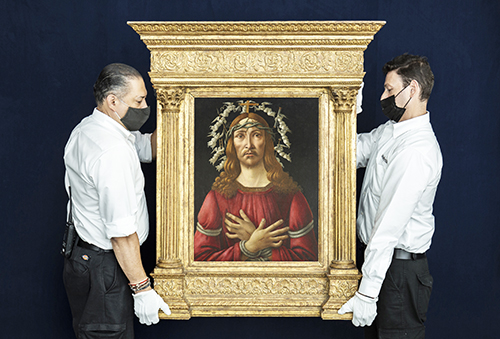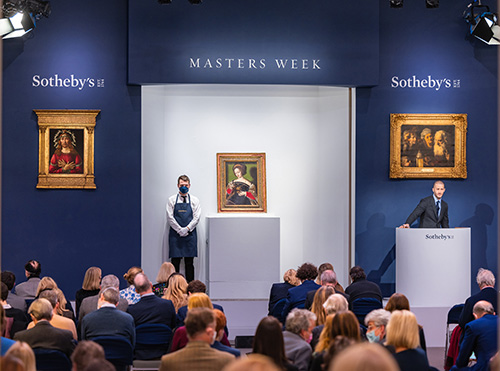소더비, 보티첼리 예수의 초상 'The Man of Sorrows' 4천540만 달러 낙찰
Sandro Botticelli’s The Man of Sorrows Sells for $45.4 Million at Sotheby’s New York
Among the Highest Prices Ever Achieved for a Renaissance Painting
& Second Highest Auction Result for an Old Master Painting in the Last 5 Years
4,500 Year Old Egyptian Limestone Sculpture Sells for Standout $9.9 Million
Second Highest Auction Result for an Ancient Egyptian Work of Art

NEW YORK, 27 January 2022: Moments ago in a much-anticipated auction at Sotheby’s New York, Sandro Botticelli’s The Man of Sorrows sold for $45.4 million - among the strongest prices ever achieved for a Renaissance painting, and also the second highest price for any Old Master Painting offered at auction in the last five years.
The winning bid for Botticelli’s remarkably realistic portrayal of Christ following a 7-minute bidding battle between 3 determined bidders, with Sotheby’s auctioneer and Old Masters specialist David Pollack bringing down the hammer to applause from the room on the final bid. Dating to circa 1500, the painting formed the centerpiece of today’s ‘phygital’ live streamed Master Paintings Part I auction at Sotheby’s which – still ongoing.
Only a few lots later, an Egyptian limestone figure dating to circa 2440-2355 B.C nearly doubled its high estimate to achieve $9.9 million, becoming the second highest auction result for an Ancient Egyptian work of art. The sculpture was acquired by an American private foundation.
Today’s result for the The Man of Sorrows comes almost exactly a year after the $92.2 million sale, also at Sotheby’s, of Botticelli’s Young Man Holding a Roundel - one of the most valuable Old Master Paintings ever sold at auction and also the most valuable Old Master Painting ever sold at Sotheby’s.
Despite the landmark sale last year, works by Botticelli – from any period – remain exceedingly rare at auction. His late works, in particular, very seldom appear on the market, with only three other works from this period (post 1492) known to be in private hands. The Man of Sorrows has remained in the same private collection since it was acquired at auction in 1963 for £10,000 ($28,000).
Christopher Apostle, Head of Sotheby’s Old Masters Painting Department, New York, said: “Botticelli’s Man of Sorrows is one of the most potent, humbling works I have ever encountered. Though seemingly religious, it’s a painting of enormous humanity - a portrait of human suffering and spirituality that speaks a universal language. Today’s result is not only testament to its power and importance, but also to the timelessness of works painted some 500 years ago.”

Sandro Botticelli’s The Man of Sorrows
Executed around 1500, when Botticelli was greatly influenced by the fanatical Dominican friar Girolamo Savonarola, the painting demonstrates the deep spirituality that characterised Botticelli’s later life and work. At the same time, it is a remarkably realistic portrayal of Christ, capturing His divinity with enormous psychological depth and humanity.
In preparation for the sale, the painting underwent technical analysis by Sotheby’s in-house research team, during which an earlier composition - possibly for an entirely different image - was found hidden beneath the painting. In addition to which, distinct changes were also revealed in the rendering of Christ’s hands, further underscoring Botticelli’s authorship. (For further information see here)
An Egyptian Limestone Figure of a Man
Moments after the hammer fell on the Botticelli, an Egyptian Limestone Figure of a Man from circa 2440-2355 B.C. sold for $9.9 million to an American Private Foundation after it was enthusiastically chased well beyond its $3-5 million estimate by 3 bidders for nearly 12 minutes. Presented for the first time in the context of an Old Master sale, the antiquity allowed for a thought-provoking dialogue between figurative art across millennia.
Dated to the 5th dynasty, the figure was excavated and discovered at the Great Western Cemetery at Giza in 1913 by the great American archeologist, George A. Reisner, working on the behalf of the Museum of Fine Arts, Boston and Harvard University. Soon thereafter, the sculpture was awarded to the Museum of Fine Arts by the Egyptian Government Antiquities Service via division of funds, which allowed foreign expeditions to retain and export some of the material they discovered in the course of their work.
The work first appeared at auction in 1978, where it sold for $280,000, then the highest price ever achieved at auction for an ancient sculpture. It was most recently on exhibit at the Metropolitan Museum of Art in New York.




 이탈리아 명품 와인 미국 투어 트레 비키에리(NY, 2/25)
이탈리아 명품 와인 미국 투어 트레 비키에리(NY, 2/25)

